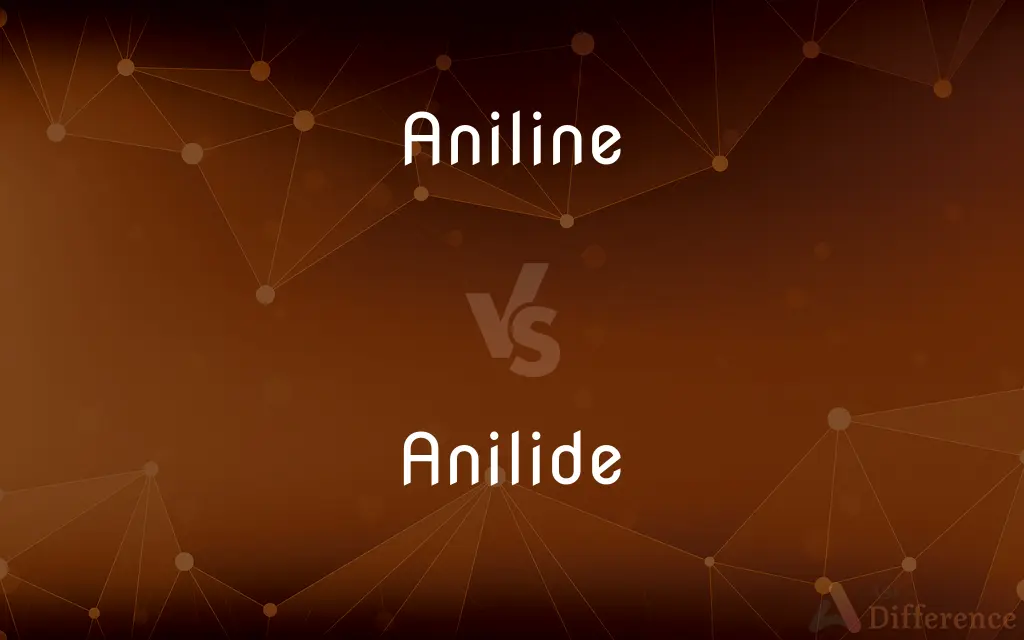Aniline vs. Anilide — What's the Difference?
By Urooj Arif & Fiza Rafique — Updated on April 23, 2024
Aniline is an aromatic amine used as a precursor in the synthesis of dyes, drugs, and plastics, characterized by an amino group attached to a benzene ring, anilide a class of compounds formed by the reaction of aniline with acyl chlorides or acids.

Difference Between Aniline and Anilide
Table of Contents
ADVERTISEMENT
Key Differences
Aniline is a basic organic chemical compound that is highly reactive and useful in various industrial applications, particularly in the production of dyes and polymers. Whereas, anilides are derivatives of aniline where the hydrogen atoms in the amino group have been replaced by acyl groups, making them less reactive and typically more stable.
Chemically, aniline is an amine, meaning it contains nitrogen atoms bonded to hydrogen and carbon. On the other hand, anilides are amides, which contain a carbonyl group (C=O) bonded to the nitrogen atom instead of hydrogen atoms, changing their chemical properties and applications.
Aniline is known for its distinctive, unpleasant smell and its tendency to darken upon exposure to air and light due to its high reactivity. In contrast, anilides generally do not have strong odors and are more resistant to similar environmental factors due to their more stable structure.
In terms of usage, aniline is directly utilized as a building block in the synthesis of numerous commercial and industrial products. Anilides, on the other hand, often serve as intermediates in the production of pharmaceuticals and specific types of specialty plastics.
While aniline poses significant health hazards, such as toxicity and potential carcinogenic effects, anilides, depending on their specific chemical structure, tend to exhibit varying toxicity levels, often less than aniline but still significant depending on the acyl group attached.
ADVERTISEMENT
Comparison Chart
Chemical Structure
Amino group attached to benzene ring
Amino group bonded to a carbonyl group
Type of Compound
Amine
Amide
Reactivity
Highly reactive, sensitive to light and air
Less reactive, more stable
Odor
Distinctive, unpleasant
Generally mild or odorless
Primary Use
Production of dyes, drugs, plastics
Intermediate in pharmaceuticals, plastics
Compare with Definitions
Aniline
A simple aromatic amine used as a precursor to various chemicals.
Aniline is essential in the synthesis of methylene blue dye.
Anilide
Generally exhibits lower reactivity compared to aniline.
Anilides are more shelf-stable than their precursor, aniline.
Aniline
A colorless oil that darkens when exposed to air.
The sample of aniline had darkened significantly when left uncapped.
Anilide
Utilized in the synthesis of more complex chemical structures.
Anilides are key intermediates in the production of certain synthetic fibers.
Aniline
Serves as a base in creating polyurethane foam.
Aniline reacts with diisocyanates to form rigid polyurethane foams.
Anilide
Less toxic than aniline but still requires careful handling.
Despite being less harmful, anilides must be handled with care in labs.
Aniline
Toxic and can be absorbed through the skin.
Workers handling aniline wear protective gear to avoid exposure.
Anilide
Involved in the creation of certain dyes and pigments.
Some anilides are precursors for dyes that are more stable than those derived directly from aniline.
Aniline
Important in the rubber industry for processing.
Aniline is used to accelerate the vulcanization process in rubber manufacturing.
Anilide
A derivative of aniline where the amino group bonds with an acyl group.
Acetanilide is a common anilide used in some pharmaceuticals.
Aniline
Aniline is an organic compound with the formula C6H5NH2. Consisting of a phenyl group attached to an amino group, aniline is the simplest aromatic amine.
Anilide
Anilides (or phenylamides) are a class of chemical compounds which are acyl derivatives of aniline.
Aniline
A colorless, oily, poisonous benzene derivative, C6H7N, used in the manufacture of rubber, dyes, resins, pharmaceuticals, and varnishes.
Anilide
(organic chemistry) Any organic compound derived from an oxoacid by replacement of a hydroxyl group by an aniline residue; an amide of aniline.
Aniline
Derived from aniline.
Anilide
(organic chemistry) Any compound in which one of the nitrogen-bound protons of aniline is replaced by a metal or other cation.
Aniline
(organic compound) The simplest aromatic amine, C6H5NH2, synthesized by the reduction of nitrobenzene; it is a colourless oily basic poisonous liquid used in the manufacture of dyes and pharmaceuticals.
Anilide
One of a class of compounds which may be regarded as amides in which more or less of the hydrogen has been replaced by phenyl.
Aniline
An organic base belonging to the phenylamines. It may be regarded as ammonia in which one hydrogen atom has been replaced by the radical phenyl. It is a colorless, oily liquid, originally obtained from indigo by distillation, but now largely manufactured from coal tar or nitrobenzene as a base from which many brilliant dyes are made.
Aniline
Made from, or of the nature of, aniline.
Aniline
Oily poisonous liquid amine obtained from nitrobenzene and used to make dyes and plastics and medicines
Common Curiosities
Why is aniline considered hazardous?
Aniline is toxic and can cause methemoglobinemia, a serious blood disorder.
How are anilides formed from aniline?
Anilides are formed by reacting aniline with acyl chlorides or carboxylic acids.
Can aniline and anilides be found in everyday products?
Yes, they are present in products ranging from medications to industrial chemicals.
What precautions are necessary when working with aniline?
Protective clothing, proper ventilation, and avoiding skin contact are essential.
How is aniline stored to prevent degradation?
Aniline should be stored in a cool, dark place in tightly sealed containers to prevent oxidation.
Are anilides safer than aniline?
Anilides generally have a lower risk profile compared to aniline but are still handled with caution.
What are the industrial uses of aniline?
Aniline is primarily used in the manufacture of dyes, pharmaceuticals, and polymers.
What are some common anilides and their uses?
Common anilides like acetanilide are used in pharmaceuticals and as intermediates in chemical synthesis.
What environmental considerations are there for aniline and anilides?
Both chemicals need careful disposal to avoid environmental contamination.
How do the physical properties of aniline and anilides differ?
Aniline is a colorless, volatile liquid, while anilides are usually solid at room temperature.
What first aid measures should be taken in case of aniline exposure?
Immediate medical attention, oxygen therapy, and removal of contaminated clothing are critical steps.
What role do anilides play in medicine?
Some anilides are used as intermediates in the synthesis of analgesics and other drugs.
Is aniline flammable?
Yes, aniline is flammable and requires careful storage.
What are the benefits of using anilides in industrial applications?
Anilides offer chemical stability and specificity in synthesis, beneficial in fine chemical manufacturing.
Can anilides be used directly in consumer products?
Typically, anilides are not used directly but as intermediates in the production of more complex compounds.
Share Your Discovery

Previous Comparison
Ride vs. Drive
Next Comparison
Simmerstat vs. ThermostatAuthor Spotlight
Written by
Urooj ArifUrooj is a skilled content writer at Ask Difference, known for her exceptional ability to simplify complex topics into engaging and informative content. With a passion for research and a flair for clear, concise writing, she consistently delivers articles that resonate with our diverse audience.
Co-written by
Fiza RafiqueFiza Rafique is a skilled content writer at AskDifference.com, where she meticulously refines and enhances written pieces. Drawing from her vast editorial expertise, Fiza ensures clarity, accuracy, and precision in every article. Passionate about language, she continually seeks to elevate the quality of content for readers worldwide.














































